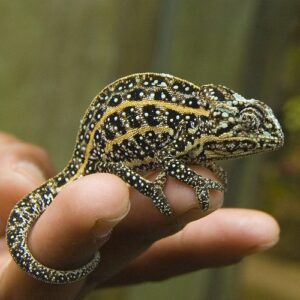
We know chameleon to be many things around the world. Some consider this reptile with funny body as poisonous, strange, a bad omen and dangerous. However, there are people who love these reptiles and can pay so much to have them as pets. It may surprise you to know that this farming has become a lucrative business in Kenya.

In the Kirinyaga district of Central Kenya, a group of farmers has started this rare farming that is targeted at both the international and local markets. They capture these reptiles, rear them and end up selling them. This exotic farming is not as simple as it looks. Take for instance, a Kirinyaga eco tourism Self Help Group started chameleon farming to diversify and ended up facing challenges of entering the high class product of the international market .
The group sells over 2,000 chameleons in the local market yearly. Today, some Kenyans are gradually identifying with chameleons. These reptiles are kept as pets and for the beautification of their homes. To break through the market, these farmers have to bust thee myth surrounding the chameleons. It is erroneously believed that the saliva of chameleons is poisonous and can kill people. The awareness created by the group has lead to a major surge in the demand of buying more chameleons.
Kenya is currently fighting the already established markets of Tanzania and Madagascar, that the world recognizes in the market. According to statistics from the Convention on International Trade in Endangered Species (CITES), Madagascar exports up to five different chameleon species that are up to 66,500.

Kenyans have a difficult time looking for a niche in the international market. The online has been used by Kenyans to ensure that they are seen. However, there are times they get buyers from the international market, and are unable to meet up because other countries pull the deal away from them.
This challenge has led the chameleon farmers to have excess chameleons that they don’t know what to do with. Often, they send some of these chameleons back to the forest to save losses. Chameleon farming demands extra monitoring and attention. This may have explained the reason why some farmers are not willing to start the business.

Chameleons require a natural breeding environment to allow them feed on smaller insects. The farmers in Kenya have learned to attract insects with rotten foods placed inside the reptiles’ rearing cot. Locusts are some of the insects that the farmers try to attract to the chameleons.
The next challenge is sensitive weather condition that will be suitable for the reptiles. Chameleons can die during the cold seasons. Also, they are known to be cannibals. The males eat the young ones and the farmers make sure that the males are separated.
To export these chameleons, the farmers must get permission from the Kenya Wildlife Services(KWS), who has to supervise the breeding ground of the chameleons and determines if the farmers will get a permit. The farmers must meet the CITES requirements and meet the export requirements that is expected of them. The Jackson’s chameleon is the most sought after breed and it is what the Kenyan farmers breed.

